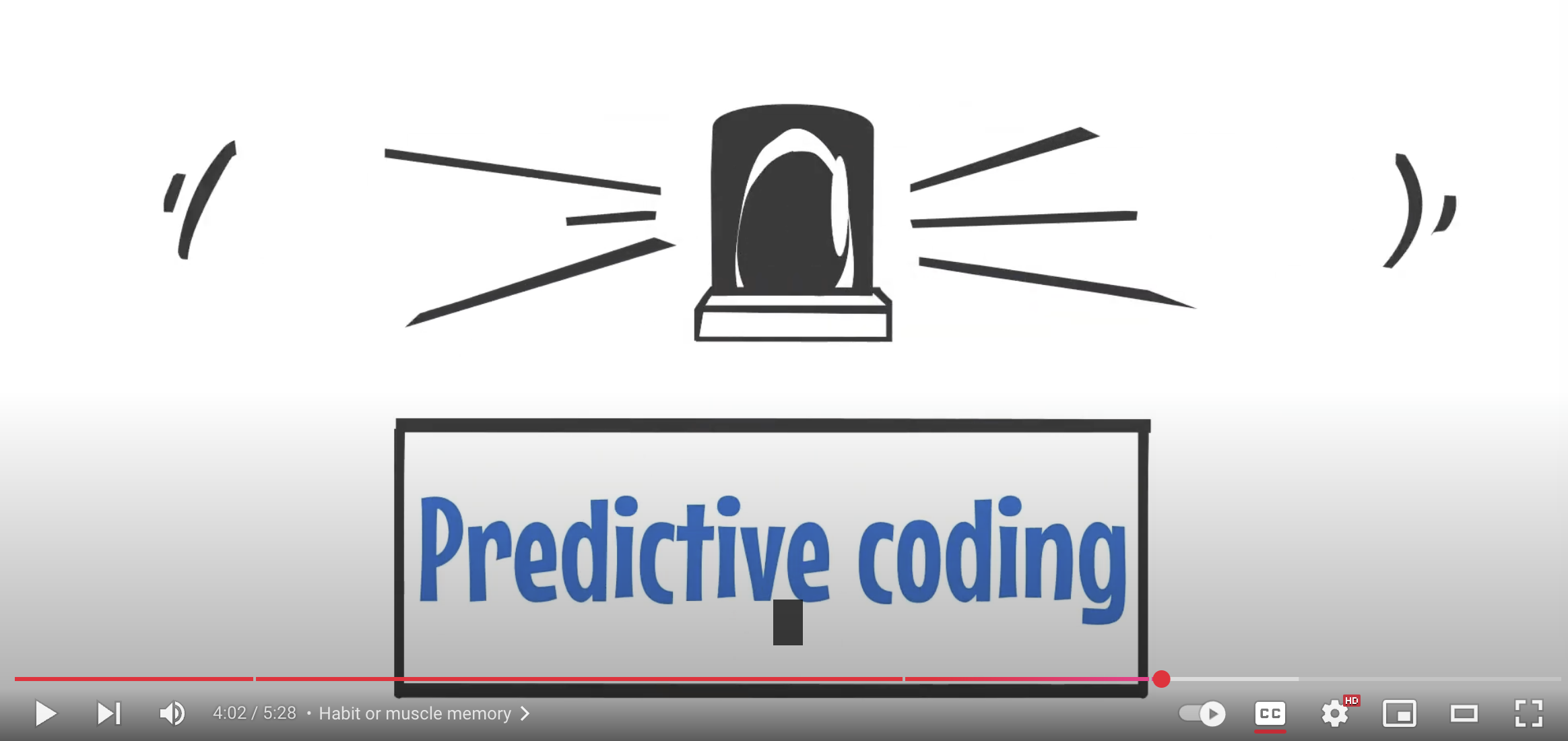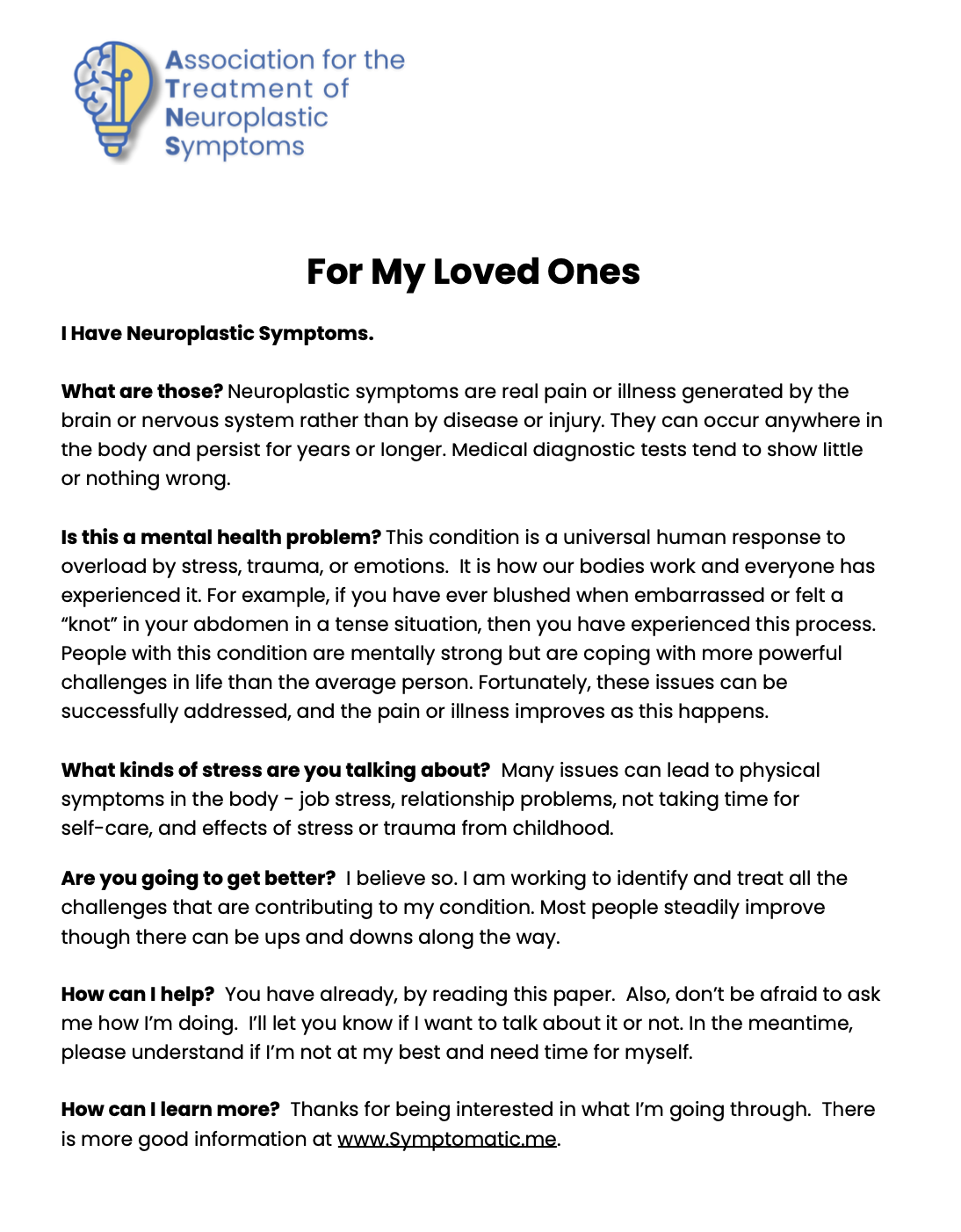
As you scroll down, the resources below begin with several easy introductions and then increase gradually in complexity to a deeper understanding of how to diagnose and treat neuroplastic pain and illnessLearning Program
Neuroplastic Symptom Practitioner Questionnaire
Watch the Pain Science Paradigm Shift
The groundbreaking science of chronic pain (and other symptoms) is explained by scientists who did the research, clinicians who put it into practice, and patients who experienced the life-changing benefits.
Learn from frequently asked questions
-
They are pain or illness caused not by disease or injury but rather by stress, trauma, emotions, or other life challenges.
-
They can appear as pain, fatigue, digestive issues, headaches, and many other physical conditions. It is common for these symptoms to move around the body, to have more than one at a time, and to last for years.
-
The more questions to which you answer “Yes” on our 12 Question Quiz, the more likely it is that your pain or illness have a neuroplastic cause.
-
Yes, stress and emotional factors can trigger or worsen real pain or illness. A mild version of the process is the way a tense situation can lead to feeling a “knot” in your abdomen or a tough day can cause a headache.
-
Neuroplastic symptoms are driven by altered nerve pathways in the brain rather than the structural damage or disease that can be seen with medical tests.
-
No, the symptoms are just as real as pain or illness caused by damage or disease. The good news is that successful treatment is available.
-
First, medical tests rule out organ disease or structural damage. Additional clues come from “Yes” answers in the 12 Question Quiz. Next is assessment for stress, trauma, emotions and other life challenges. Finally, the diagnosis is confirmed when treatment of those issues leads to significant improvement or complete relief.
-
Treatment begins with eliminating the fear that your body is damaged. Then, uncovering stress, trauma, emotions, and other challenges leads to using strengths you already possess to reduce the impact of these issues. Research shows powerful benefits from this approach.
-
Yes, research shows that a majority of people with neuroplastic symptoms improve significantly or have complete relief using the approach in the resources on this website. This is true even for people with severe, long-lasting pain or illness who have tried many other treatments.
-
Yes, ongoing physical symptoms can lead to anxiety, depression, and emotional distress, creating a cycle that worsens both physical and mental health.
Watch the Neuroplastic Pain 101 Video Series
New episodes available regularly on Spotify, Apple, and YouTube.
When a person experiences pain or illness but doctors find no disease or injury to explain it, their symptoms become a medical mystery. To unravel the enigma, David Clarke, MD, finds The Story Behind the Symptoms. He looks for clues in the guest’s present and past, just as he has for over 7,000 people throughout his career. Many of these unexplained symptoms stem from neuroplastic processes—pathways in the brain and nervous system that are learned in response to stress, trauma, and adversity, often starting in childhood. But when these patterns are uncovered and understood, this knowledge becomes healing without the need for invasive procedures or long-term medical treatment.Exclusive access to our Self-Treatment Course
Join a rapidly growing community that is changing medical practice so that everyone with neuroplastic symptoms can receive the relief they deserve.
Monthly Exclusive Online Q&As (one for practitioners, one for everyone)
Approved practitioners can be listed in our Directory
Discounts for online courses
Discounts to annual Conferences (digital and in-person)
Discounts for three remarkable documentary films
Exclusive webinars
Membership Benefits
Explore these textbooks
Learn how to talk to
Explore these resources for children and teens
Mastering the Mind-Body Connection for Teenagers
By Dr. David Schechter
Discover the powerful link between mind and body. Manage stress, balance life, and harness the placebo effect with practical tools and insights for teens. Learn how expressive writing or journaling can provide emotional insight and release.
Jamie Shafir, Licensed Clinical Social Worker Mind Body Therapy & Coaching Center
3 Week Introductory Course (free) Covers psychoeducation, tools, action planning, and parent tips.
7 Week Intensive Course (fee-based) Builds on the introductory course with deeper strategies and personalized plans.
These courses are designed for children and parents.
Visit these resourceful websites
Medical Myopia and Common Sense - Blog post by PPDA Co-Founder Dr. Howard Schubiner commenting on several recent publications in the news media and scientific journals.
MindbodyMedicine.com - Educational programs and books by Dr. David Schechter
PathwaysToPainRelief.com - Book, continuing education and other resources by Frances Sommer Anderson, PhD and Eric Sherman, PsyD
SIRPA.org - The Stress Illness Recovery Practitioners’ Association founded by Georgie Oldfield, MCSP. SIRPA, like the PPDA, also educates health professionals on how to diagnose and treat PPD and provides patient resources.
StressIllness.com - Educational resources by Dr. David Clarke, M.D.
TMSWiki.org - Founded by Rob Munger, the TMS Wiki focuses on Tension Myoneural Syndrom recovery success stories as a healing resource for patients, with lots of forums for patients to share their stories and ask questions with a TMS/PPD practitioner. Alan Gordon’s free pain recovery program is also available as one of many resources.
UnlearnYourPain.com - Online Mind Body Program, continuing education, books and other offerings by Dr. Howard Schubiner, M.D.

















